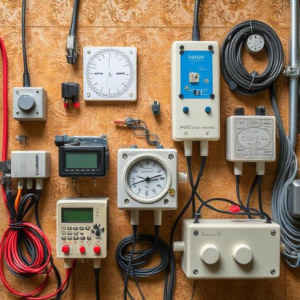Circuits
A circuit is a path for the flow of electricity. It consists of:
- A power source(e.g., battery).
- Conductors(wires).
- A load(device like a light bulb).
- A switch to control the flow.

AC vs. DC
- DC (Direct Current): The flow of electric charge is in one direction. Example: A battery produces DC electricity.
- AC (Alternating Current): The electric charge periodically reverses direction. Example: Wall outlets supply AC power in homes.
Power
The electrical power is the rate at which electrical energy is used or produced. It’s calculated by:
P=V×I
- P is power (measured in watts).
- V is voltage.
- I is current.
If you multiply the voltage (push) by the current (flow), you get the power (in watts).
Types of Circuits:
- Series Circuit: Components are connected end-to-end. If one component fails, the entire circuit is broken.
- Parallel Circuit: Components are connected in parallel branches. If one component fails, the others still work.
Common Electrical Devices are :
- Resistor: A component that limits the current flow, creating resistance in a circuit.
- Capacitor: Stores electrical energy temporarily and releases it when needed.
- Inductor: A coil of wire that stores energy in a magnetic field when current flows through it.
- Diode: Allows current to flow in only one direction.
- Transistor: A device used to amplify or switch electrical signals.
Tags: AC electricity, AC vs DC, alternating current, battery, capacitor, Circuit Components, circuit control, circuit design, circuit types, Circuits, conductors, current, current flow, DC electricity, Diode, Direct Current, Electric circuits, electrical basics, electrical devices, electrical energy, electrical power, Electricity, electricity flow, electricity in circuits., Electronic Components, energy storage, home electricity, Inductor, load, P=VI, parallel circuit, power calculation, power formula, power source, Resistor, series circuit, switch, transistor, voltage, watts, wires


